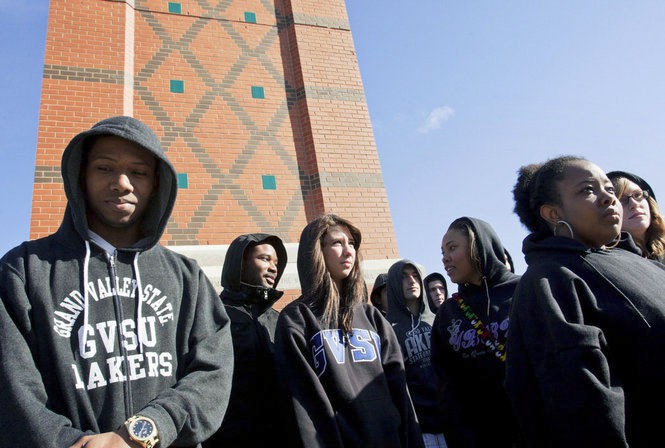“Do I look suspicious?”

Courtesy Photo / mlive.com Students from Dr. Rik Stevenson’s Intro to African American Studies class
Apr 16, 2012
When Rik Stevenson walked into his classroom at Grand Valley State University wearing a hooded sweatshirt, the black professor looked at his class and asked a simple, but loaded question: “Do I look suspicious?”
The introduction was part of a larger effort Stevenson would lead his Introduction African American studies students in, using investigative skill to follow up on the recent shooting death of Trayvon Martin.
After seeing a photograph of the Miami Heat basketball team posing wearing hoods in memory of Martin’s death, Zachary Whittle, a student in Stevenson’s class, presented the idea to have the class take their own photo, but Stevenson challenged his class to think of an action that would have a bigger impact than a photograph.
With Stevenson’s guidance, the class created a special project covering the Trayvon Martin case, including an article, photo and video the class members all participated in creating. Their objective was to critically investigate the case and research the laws involved.
Martin, a 17-year-old black male, was found shot to death by self-appointed neighborhood watchman George Zimmerman last month. Zimmerman had called 911 to report Martin as “suspicious.” Zimmerman asked the dispatcher whether he should take action, but was told to wait for officers to respond to the scene. Zimmerman pursued Martin, who was unarmed and carrying Skittles and an Arizona Iced Tea, but Zimmerman claims the shooting was in self defense.
Zimmerman was charged with second-degree murder Wednesday and was brought to the Seminole County jail in Jacksonville, Florida.
In the class’ article, which largely summarized the case, attempted to explore why Zimmerman pursued Martin after being told not to by the dispatcher.
As a professor who is clearly enthused about his discipline, Stevenson makes sure his students are challenged and made to think about their effect on the world.
“Students have the responsibility not only to get a degree, but also to affect their circles of influence,” Stevenson said, “Because they are the future and they have to ask themselves the question: what kind of world do they want to live in, and also what kind of world do they want to leave to their children?”
Stevenson said his initial hope for this project was for his students to sense their power.
“Students are important to the success of this country,” Stevenson said.
Zachary Whittle, a sophomore and nursing major, in Stevenson’s class said the purpose of the project was to bring awareness of the case to students at GVSU, but also to the community.
“My hopes for the project were to inform people of the shooting, and to encourage them to take action and support what they think is right,” Whittle said. “We decided to do the project because we felt there were many people who didn’t know about the shooting so we wanted to raise awareness, and also we felt that the crime wasn’t handled properly and that it hasn’t seen justice yet.”
During the video, the students were asked to answer why they were creating the video, what they hoped to achieve and how the class was relevant to the project. The video created through this project is still being edited, but Stevenson said that the class does plan to show it publicly.
In light of the recent news, Stevenson also added how proud he was of his student’s involvement in this historical case.
“I think that the work that the class did was ‘rewarded’ by the arrest,” Stevenson said. “Now I realize that this was a nationwide effort but, these students were a part of history. The article that was published by GR Press will go down in history. Years from now these students will be able to say to their children, their students and their family, that they participated in a historical event. They will be able to pull up this article and show what they did in an attempt to bring justice for a child who could be on his way to college.”























